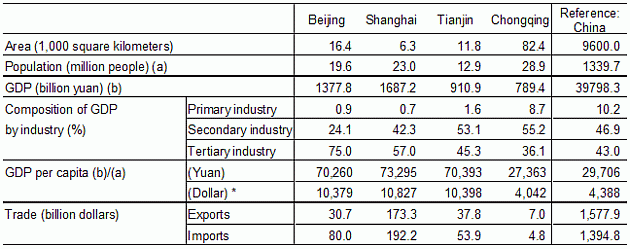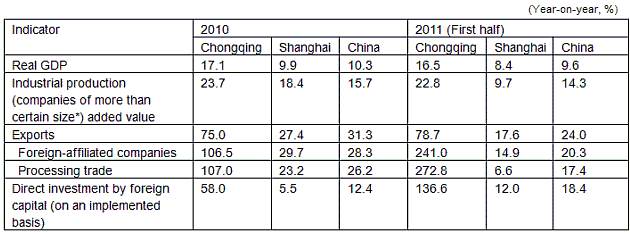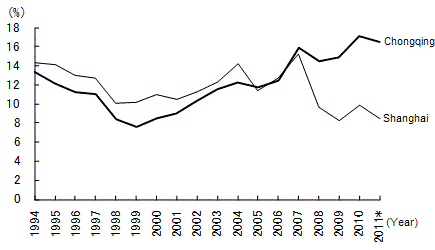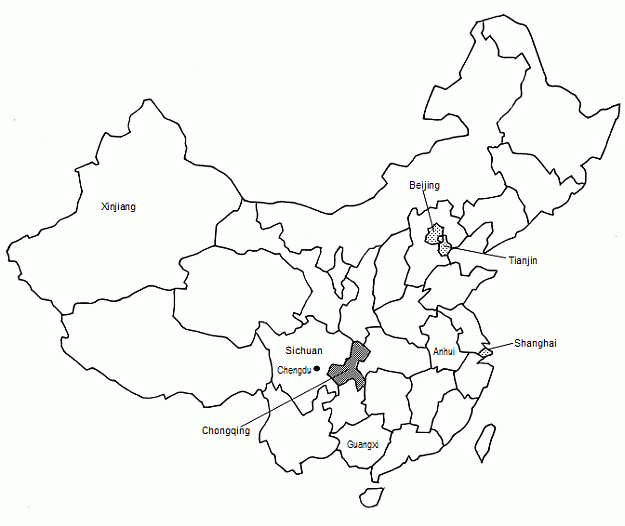In recent years, Chongqing has emerged as a growth spot in China, thanks to the Western Development project, a national program to help the underdeveloped western region catch up with the more prosperous eastern region, as well as the shift of industries from coastal regions to inland areas. In addition to the existing automobile and motorcycle, equipment manufacturing, basic materials, natural gas, and petrochemical industries that mainly serve the domestic market, the electronic information industry for exports has also been emerging rapidly as a new growth engine. Meanwhile, to support the further development of Chongqing, the central government has been launching such activities as authorizing the establishment of the Chongqing Liangjiang New Area as its third state-level new economic development area, following Pudong in Shanghai and Binhai in Tianjin. Taking advantage of such favorable market and policy environments, Chongqing aims to make a further great leap forward by including a high growth target of 12.5% in its 12th Five-Year Plan (2011 through 2015).
Outstanding economic performance
Chongqing, a city located in the southeast of the Sichuan Basin, has been an important transportation hub since early times, as it was the meeting point of the Yangtze and Jialing rivers. Although it used to fall under the administration of Sichuan Province, it became the fourth direct controlled municipality in China in 1997, after Beijing, Shanghai, and Tianjin (Table 1). The city was given its new status to facilitate the economic development in the inland region, narrow the gap between the coastal area and the inland region, and aid in the resettlement of residents (approximately one million people) from the reservoir areas of the Three Gorges Dam project. As Chongqing has become a direct controlled municipality, an administrative region at the same level as a province, support from the central government has been bolstered. In addition, as the "distance" between Chongqing and the center of political power has been shortened significantly in both the hierarchies of the Communist Party and the government, more senior cadres have been assigned to top posts in the municipal government. Their strong ties with China's top leaders have made it easier for Chongqing's demand to be reflected in the policies of the central government.
Table 1: Comparison of the Four Direct Controlled Municipalities (2010) |
 |
| * Yuan figures have been converted into U.S. dollars at the annual average rate for 2010 (1 dollar = 6.7695 yuan). |
| Source: Based on China Statistical Abstract 2011. The "areas" of the municipalities are obtained from the official websites of their respective governments. |
Chongqing inherited a certain industrial base built in the 1960s when it played an important role in the Third Front construction project which aimed to divert industries to the inland region as part of China's effort to prepare for wars. Chongqing has been growing rapidly in recent years, seizing the golden opportunities offered by such national projects as the China Western Development and the shift of industries from the coastal area to the inland region. Reflecting this, the growth rates of major economic indicators, which indicate the growth potential of Chongqing, including real GDP, have been exceeding the indicators of the country as a whole as well as those of Shanghai, which has been leading the Chinese economy, by a large margin (Table 2, Figure 1). Chongqing's GDP growth was 17.1% in 2010, the second highest in China after Tianjin. Exports jumped 75.0% year on year, of which, exports by foreign-affiliated companies and processing trade soared 106.5% and 107.0% year on year, respectively. This reflects growth of 58.0% year on year in direct investments by foreign capital (on an implemented basis). Not only foreign capital, but investments from other regions of China also rose 79.7% year on year. Strong growth in the Chongqing economy has been continuing, with real GDP growth in the first half of 2011 reaching 16.5%. Exports in the first half climbed 78.7% year on year, of which, exports by foreign-affiliated companies and processing trade rose significantly, up by 241.0% and 272.8% year on year, respectively. Direct investments by foreign capital also rose 136.6% year on year on an implemented basis.
Table 2: Comparison of Major Economic Indicators in Chongqing, Shanghai, and China |
 |
| *State-owned firms and non-state-owned firms with annual revenue from principal business over five million yuan |
| Sources: Based on the National Bureau of Statistics of China, Chongqing Statistics Bureau, and Shanghai Statistics Bureau |
Figure 1: Chongqing Exceeding Shanghai in Economic Growth |
 |
| *For the first half of 2011 |
| Source: Based on CEIC Database |
It has been the remarkable development of manufacturing industries that has supported high growth in Chongqing. In addition to the existing automobile and motorcycle, equipment manufacturing, basic materials, natural gas and petrochemical industries, the electronic information industry has also been developing strongly as a new growth engine (Table 3). In particular, growth in the production of notebook computers has been striking. Although the production of these types of computers was nil in 2009, production reached 1.89 million units in 2010 and 7.29 million units in the first half of 2011, thanks to a wave of investment by the world top brands and EMS makers, including Hewlett-Packard, Foxconn, Inventec, Quanta Computer, and Acer. Chongqing has announced targets of 100 million units for annual production and 80% for the local procurement ratio of components and raw materials by 2015. If these targets are achieved, Chongqing will become the world's largest producer of notebook computers.
Table 3: Development of Key Industries in Chongqing (First Half of 2011) |
 |
| Note: Only companies greater than a certain size (annual revenue from principal business over five million yuan) are covered. |
| Source: Based on Chongqing Statistics Bureau |
As a production base for exports of foreign-affiliated companies, however, Chongqing is disadvantaged by its inland location, compared with coastal area. Nevertheless, significant progress has been made in finding a solution to this problem, as a new railway line (Chongqing-Xinjiang-Europe) began operations in spring 2011 as part of the New Eurasia Land Bridge, a railway network connecting China with Europe.
Full support of the central government
The central government places great value on the role of Chongqing as a driving force of the China Western Development and has launched measures to support the city with further development.
First, the State Council designated Chongqing, as well as Chengdu, as a National Economic Experimental Zone for Urban-Rural integration in June 2007 and announced Various Opinions on Promoting Reform and Development of Urban-Rural Integration in Chongqing Municipality in January 2009. Under these announcements, Chongqing was positioned as an important growth spot in the China Western Development project, an economic center serving the Upstream Yangtze area, and a model district for the development of urban-rural integration. Guided by the "opinions," Chongqing is actively advancing the conversion of the rural register of migrant workers who have relocated to urban areas to the urban register, ahead of other regions.
In addition, with the approval from the State Council, the Liangjiang New Area of Chongqing was established in June 2010 as the third state-level new economic development area, after Pudong in Shanghai and Binhai in Tianjin, and the sole state-level new economic development area in the inland region. The Liangjiang New Area, located in Chongqing's urban area north of the Yangtze River and east of the Jialing River, covers 1,200 square kilometers, with 550 square kilometers earmarked for development and the remaining 650 square kilometers for a green zone. The Liangjiang New Area aims to become an area with "one gateway, two centers, and three bases;" that is, an important gateway linking the western region to the world; a modern commercial and logistics center and a financial center in the Upstream Yangtze area; and an important base for modern manufacturing and high-tech industries, an inland transit base for the relay of international trade and the processing of export products, and a base to commercialize scientific and technological achievements and the results of scientific research in the Upstream Yangtze area. The development of Liangjiang New Area has been included in the 12th National Five-Year Plan as a symbol for the opening-up of the inland region to the world.
Moreover, in February 2011, Yanjiang in Chongqing was approved by the National Development and Reform Commission as the third "model district to accept the relocation of industries" in China, after Wangjiang in Anhui Province and Guidong in the Guangxi Zhuang Autonomous Region. Based on existing industries, Yanjiang will selectively accept the following seven major industries, namely, the advanced manufacturing, electronic information, new materials, biotechnology, chemical, light manufacturing, and modern service industries.
In March 2011, the Standing Committee of the State Council approved the Chengdu-Chongqing Economic Zone Plan, centering on Chongqing and Chengdu in Sichuan Province and covering an area of 206,000 square kilometers, with a population of approximately 100 million. This plan emphasizes that the acceleration of development of the Chengdu-Chongqing Economic Zone will have important implications for deepening the China Western Development strategy, promoting the cooperative development of the region, and bolstering the total power of the country. The Chengdu-Chongqing Economic Zone aims to become the fourth axis for growth in China, following the Pearl River Delta Economic Zone in Guangdong Province, the Yangtze River Delta Economic Zone centering on Shanghai, and the Bohai Bay Economic Rim centering on Beijing and Tianjin, based on the development of the eight largest industries, namely, equipment manufacturing, automobile and motorcycle manufacturing, electronic information, civil aerospace, metallurgic and basic materials, chemical, light manufacturing, such as textiles, and pharmaceutical industries.
The next five years will be a period marking a significant leap forward
Taking advantage of such favorable market and policy environments, Chongqing has set the following ambitious targets in its 12th Five-Year Plan (2011 through 2015).
- Formation of a growth spot in the western region: Aim for an annual average real GDP growth rate of around 12.5% (7.0% for the country), GDP of 1,500 billion yuan in 2015, which is approximately double the GDP in 2010, and GDP per capita of 50,000 yuan or higher.
- Establishment of three centers: Establish a financial center, a commercial trade logistics center, and a science, education, culture and information center in the Upstream Yangtze area.
- Narrowing of three gaps: Make "become rich together" a reality by narrowing the gap between the affluent and the impoverished, between urban and rural areas, and between regions. Aim to equalize public services between regions by reducing the residential revenue gap between urban and rural areas to around 2.5:1 and the income gap between the central area and peripheral areas to 2:1.
- Construction of "five Chongqings" Basically realizing the goal of making Chongqing a pleasant place to live, a place with convenient transportation, a very green place, a safe and secure place, and a place where everyone can live in health.
- Full-scale improvement of people's lives: Continue to use more than half of spending in the general fiscal budget for the improvement of people's livelihood. Reduce the unemployment rate in urban areas to 4% or less. Raise the pension coverage rate to 80% and the health insurance coverage rate to 95%.
- Strengthening of social development: Lay out the framework to provide basic public services in urban and rural areas. Hold down the annual rate of the natural increase in population to 0.55% or less.
- Construction of the core area for opening up the inland region to the world: Aim for total imports and exports of $100 billion or more, cumulative direct inward investment of $50 billion, and cumulative foreign direct investment of $30 billion. Create the most dynamic and competitive area in the inland region opened to the world.
- Progress in comprehensive reformation: Achieve success in constructing institutions for the unified development of urban and rural areas and in such areas as those related to family registers, residency, and income distribution.
- Efforts for sustainable growth: Reduce energy consumption per unit of GDP by 15% and CO2 emissions per unit of GDP by 17% and secure cultivated land totaling 2,208,500 hectares.
By achieving these targets, Chongqing will become a new engine driving economic growth not only in the western region but also China as a whole.
Reference: Location of Chongqing |
 |
| (Source: Prepared by Chi Hung KWAN) |


